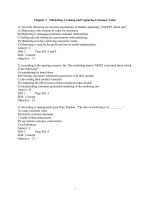Chapter 1: Matter and Measurement
Bạn đang xem bản rút gọn của tài liệu. Xem và tải ngay bản đầy đủ của tài liệu tại đây (1.78 MB, 46 trang )
General Chemistry
Principles and Modern Applications
Petrucci • Harwood • Herring
8th Edition
Chapter 14: Solutions and Their
Physical Properties
Philip Dutton
University of Windsor, Canada
N9B 3P4
Prentice-Hall © 2002
Contents
14-1
14-2
14-3
14-4
14-5
14-6
14-7
Types of Solutions: Some Terminology
Solution Concentration
Intermolecular Forces and the Solution Process
Solution Formation and Equilibrium
Solubilities of Gases
Vapor Pressure of Solutions
Osmotic Pressure
Prentice-Hall
General Chemistry: C
Slide 2 of 46
Contents
14-8
Freezing-Point Depression and Boiling-Point Elevation
of Nonelectrolyte solutions.
14-9 Solutions of Electrolytes
14-10 Colloidal Mixtures
Focus on Chromatography
Prentice-Hall
General Chemistry: C
Slide 3 of 46
13-1 Types of Solution:
Some Terminology
• Solutions are homogeneous mixtures.
– Uniform throughout.
• Solvent.
– Determines the state of matter in which the solution
exists.
– Is the largest component.
• Solute.
– Other solution components said to be dissolved in the
solution.
Prentice-Hall
General Chemistry: C
Slide 4 of 46
Table 14.1 Some Common Solutions
Prentice-Hall
General Chemistry: C
Slide 5 of 46
14-2 Solution Concentration.
• Mass percent.
• Volume percent.
• Mass/volume percent.
(m/m)
(v/v)
(m/v)
• Isotonic saline is prepared by dissolving 0.9 g
of NaCl in 100 mL of water and is said to be:
0.9% NaCl (mass/volume)
Prentice-Hall
General Chemistry: C
Slide 6 of 46
10% Ethanol Solution (v/v)
Prentice-Hall
General Chemistry: C
Slide 7 of 46
ppm, ppb and ppt
• Very low solute concentrations are expressed as:
ppm: parts per million
ppb: parts per billion
ppt: parts per trillion
(µg/g, mg/L)
(ng/g, µg/L)
(pg/g, ng/L)
note that 1.0 L 1.0 g/mL = 1000 g
ppm, ppb, and ppt are properly m/m or v/v.
Prentice-Hall
General Chemistry: C
Slide 8 of 46
Mole Fraction and Mole Percent
χ=
Amount of component i (in moles)
Total amount of all components (in moles)
χ1 + χ2 + χ3 + …χn = 1
Mole % i = χi 100%
Prentice-Hall
General Chemistry: C
Slide 9 of 46
Molarity and Molality
Molarity (M) =
Molality (m) =
Prentice-Hall
Amount of solute (in moles)
Volume of solution (in liters)
Amount of solute (in moles)
Mass of solvent (in kilograms)
General Chemistry: C
Slide 10 of 46
14-3 Intermolecular Forces and the
Solution Process
ΔHc
ΔHb
ΔHa
Prentice-Hall
General Chemistry: C
Slide 11 of 46
Intermolecular Forces in Mixtures
• Magnitude of ΔHa, ΔHb, and
ΔHc depend on intermolecular
forces.
• Ideal solution
– Forces are similar between all
combinations of components.
ΔHsoln = 0
Prentice-Hall
General Chemistry: C
Slide 12 of 46
Ideal Solution
Prentice-Hall
General Chemistry: C
Slide 13 of 46
Non-ideal Solutions
• Adhesive forces greater
than cohesive forces.
ΔHsoln < 0
Prentice-Hall
General Chemistry: C
Slide 14 of 46
Non-ideal Solutions
• Adhesive forces are less than
cohesive forces.
ΔHsoln > 0
• At the limit these solutions
are heterogeneous.
Prentice-Hall
General Chemistry: C
Slide 15 of 46
Ionic Solutions
Prentice-Hall
General Chemistry: C
Slide 16 of 46
Hydration Energy
NaCl(s) → Na+(g) + Cl-(g)
ΔHlattice > 0
Na+(g) + xs H2O(l) → Na+(aq)
ΔHhydration < 0
Cl-(g) + xs H2O(l) → Cl-(aq)
ΔHhydration < 0
ΔHsoln > 0 but ΔGsolution < 0
Prentice-Hall
General Chemistry: C
Slide 17 of 46
14-4 Solution Formation and Equilibrium
saturated
Prentice-Hall
General Chemistry: C
Slide 18 of 46
Solubility Curves
Supersaturated
Prentice-Hall
Unsaturated
General Chemistry: C
Slide 19 of 46
14-5 Solubility of Gases
• Most gases are less soluble
in water as temperature
increases.
• In organic solvents the
reverse is often true.
Prentice-Hall
General Chemistry: C
Slide 20 of 46









